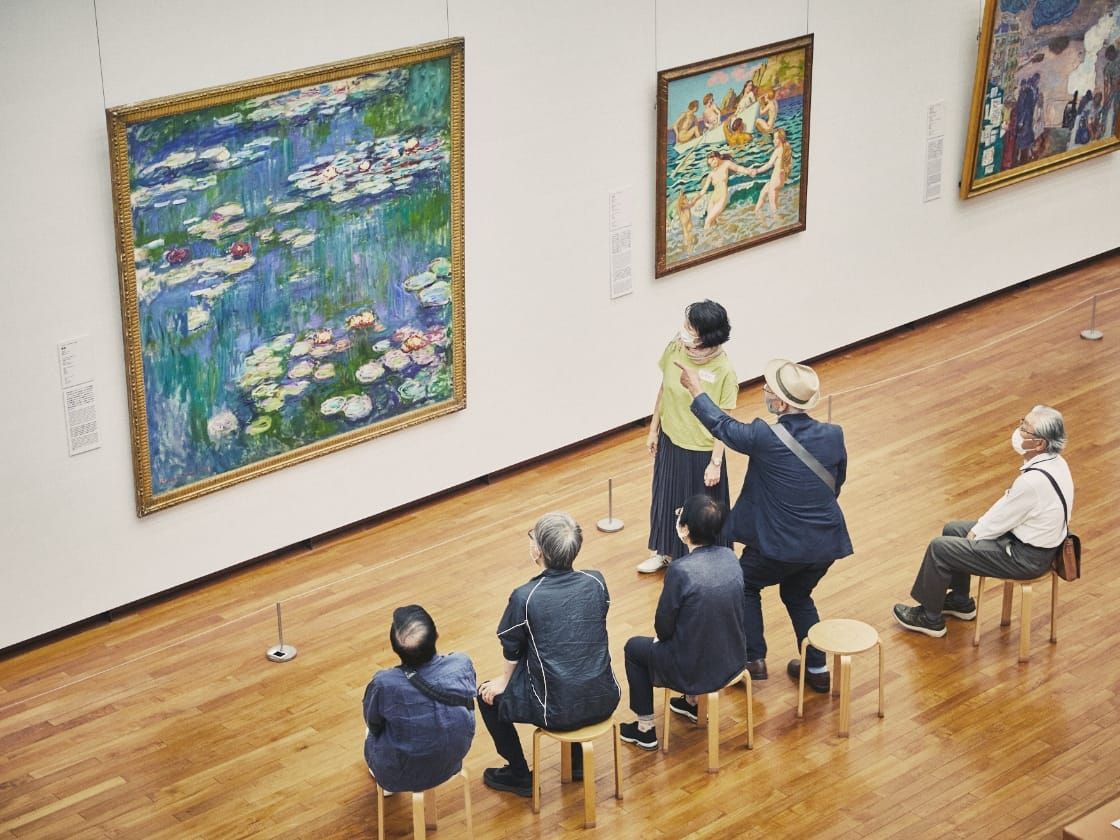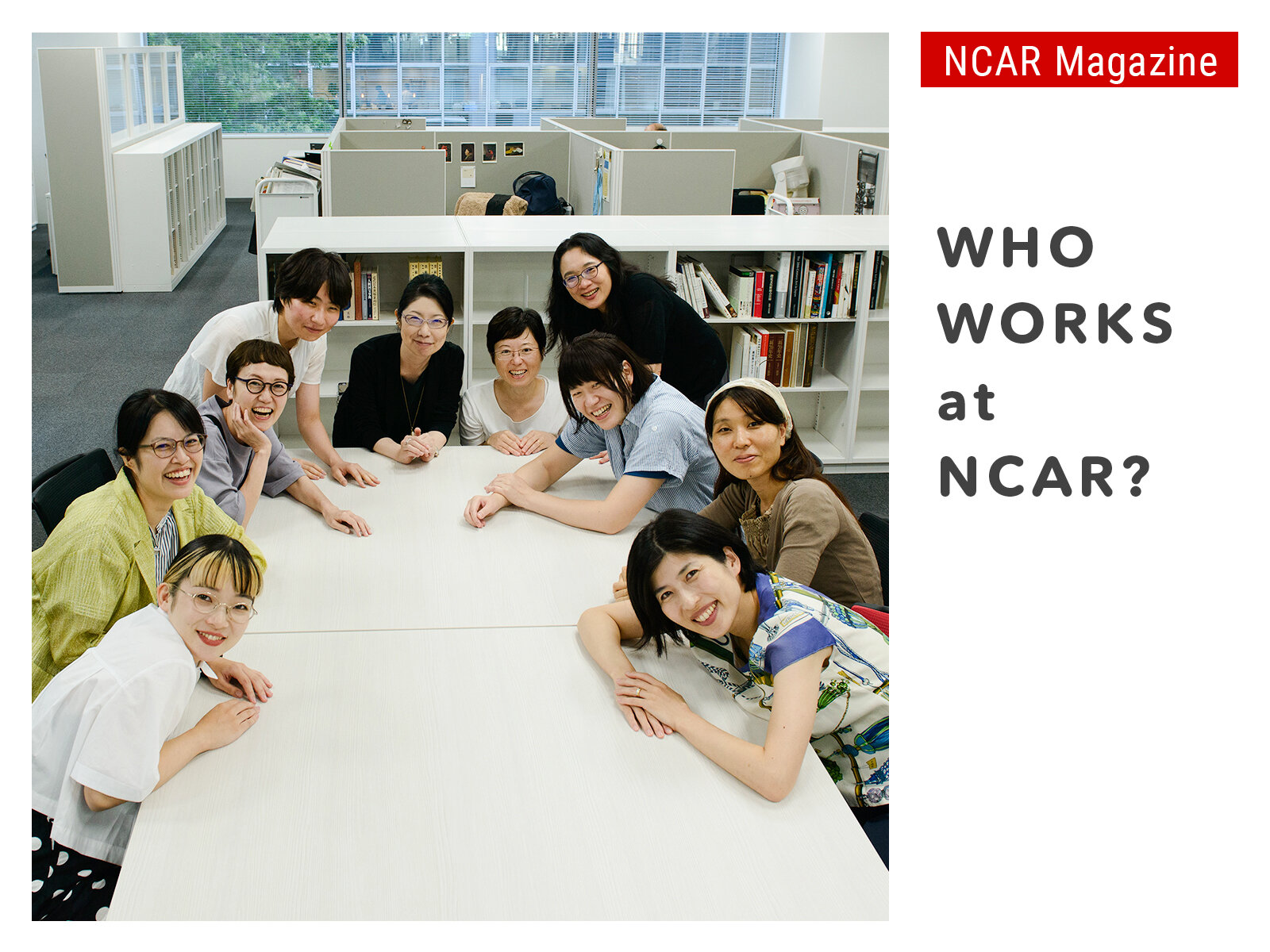WHO WORKS at NCAR? is a series of articles introducing people who work at the National Center for Art Research (NCAR). The first article focuses on the Research Resources Group and its involvement in activities to “deepen” art, which is part of NCAR’s mission of “Connecting, Deepening, and Expanding Art.”
A Portal Site that Becomes the First Stop for Art Research
This portal utilizes content from Art Platform Japan, a website that was originally developed and launched in 2018 as part of the Bunka-cho Art Platform Japan project by Japan’s Agency of Cultural Affairs with the aim of ensuring the sustained development of contemporary Japanese art. The content includes SHŪZŌ: Japanese Museum Collections Search which will evolve into a comprehensive database of art works held by art museums in Japan, and “Artists,” which enables users to search for information on artists ranging from career history through to references. NCAR has inherited this content from the Agency of Cultural Affairs, and it is now working toward its relaunch as an NCAR research portal.
The amount of data involved is massive, and to enhance accessibility, the group remains constantly conscious of the importance of standardizing notations, augmenting citations and other reference information, and providing all online information in both Japanese and English.
The aim of this initiative is to realize a portal site that will provide a first stop for research into Japanese art and raise capacity for conveying information so that people around the world can gain a deeper understanding of the significance of Japanese art.
Beginning with the experience gained at art museums
The Research Resources Group consists of four full-time staff members who work in tandem with part-time staff and subcontractors to carry out everyday operations. Each staff member had been employed at different art museums prior to joining NCAR, during which time they accumulated extensive experience, from time to time gaining insights into some of challenges that museums face. What initiatives could the NCAR Research Resources Group introduce to address such challenges? We asked the four staff members to share their thoughts.

From left, Akita Nami, Taniguchi Eri, Kawaguchi Masako, and Ishiguro Reiko.
Profiles
Kawaguchi Masako, Head of Research Resources
Joined the National Museum of Western Art in 2003 after working at a private art museum. As head of the museum’s Reference Library, supervised library activities in support of the museum’s activities. Also maintained and improved the information on the museum’s collection. Majored in history of Western art.
Taniguchi Eri, Senior Researcher, Deputy Head of Research Resources
Joined the National Art Center, Tokyo in 2007 and worked as head of Library and Archives section, joining the office for the installation and preparation of National Center for Art Research. Majored in history of Japanese modern art.
Ishiguro Reiko, Researcher
Worked as a librarian at a cultural facility while employed in the private sector. Joined a public art museum as archivist in August 2005. Joined the office for the installation and preparation of the National Center for Art Research in September 2022. Majored in history of Western art.
Akita Nami, Associate Researcher
After managing archives at a public art museum, joined the National Center for Art Research in 2022. Majored in history of postwar Japanese art.
Experiences that inform NCAR operations
— Can each of you describe your career history?
Kawaguchi The National Museum of Western Art (NMWA), where I worked before being transferred to NCAR, is sometimes perceived of as a foreign art museum within Japan.
Since its opening in 1959, researchers (curators) who had traveled to Europe or the United States to study art history not only established and maintained a research environment that’s reflective of research environments found in other countries but have also constantly strived to maintain a research environment that’s relevant.
I also studied art history in Germany as a post-graduate, and after joining NMWA, I was expected to visit other countries and to continue to learn and study.
At NMWA, I was involved in establishing a research base to contribute to museum activities such as exhibition curation and research into art works. The academic resources put in place during this time are also available to external curators and researchers.
An example of academic resources is the catalog raisonné genre, which is essentially a listing of all the works by an artist, together with information on an artist’s entire body of work so that the user can identify what works an artist created.
There is also the bibliography, used when researching a specific theme and which enables the researcher to identify which resources to refer to.
An important task during my time at NMWA was to find out whether academic resources were still available, and if so, to ensure that they were included in the research library. NMWA has greatly benefited from the highly developed research tools used overseas, and I’ve always wanted to see a bidirectional relationship, in which we can return the favor by offering similar tools from Japan to the West.

Kawaguchi Masako
Taniguchi In grad school, while studying and researching the history of Japanese modern art, I was working part-time, organizing and cataloguing materials at the Tokyo National Research Institute for Cultural Properties, a government agency.
The Tokyo National Research Institute for Cultural Properties is the oldest government agency in Japan carrying out art documentation and archiving. Having that opportunity to learn the ABCs of art history research and learn how information resources are organized, going back to prewar days, is what led to my current NCAR role.
After completing my doctorate, I joined the National Art Center Tokyo (NACT).
NACT has a library containing art-related books as well as an archival materials that won’t fit into the library, and my role was to supervise the library and archives.
In comparison to the major art museums and research institutes in the West, there was a shortage of resources, including human resources, and I found myself wondering how an optimal research environment could be established. This was when I encountered archival studies, which involves research into scientific theory and methods for the collection, organization, preservation and provision of historical records.
In Japan, the reality is that various historical records pertaining to artists, individuals in the art industry, and art-related institutions, such as letters, hand-written manuscripts, photographs, and film or video footage have often not been systematically organized, making the records difficult to access. Because of this, I’ve been boosting my knowledge of archival studies as I search for a methodology that will result in a breakthrough in the current situation.
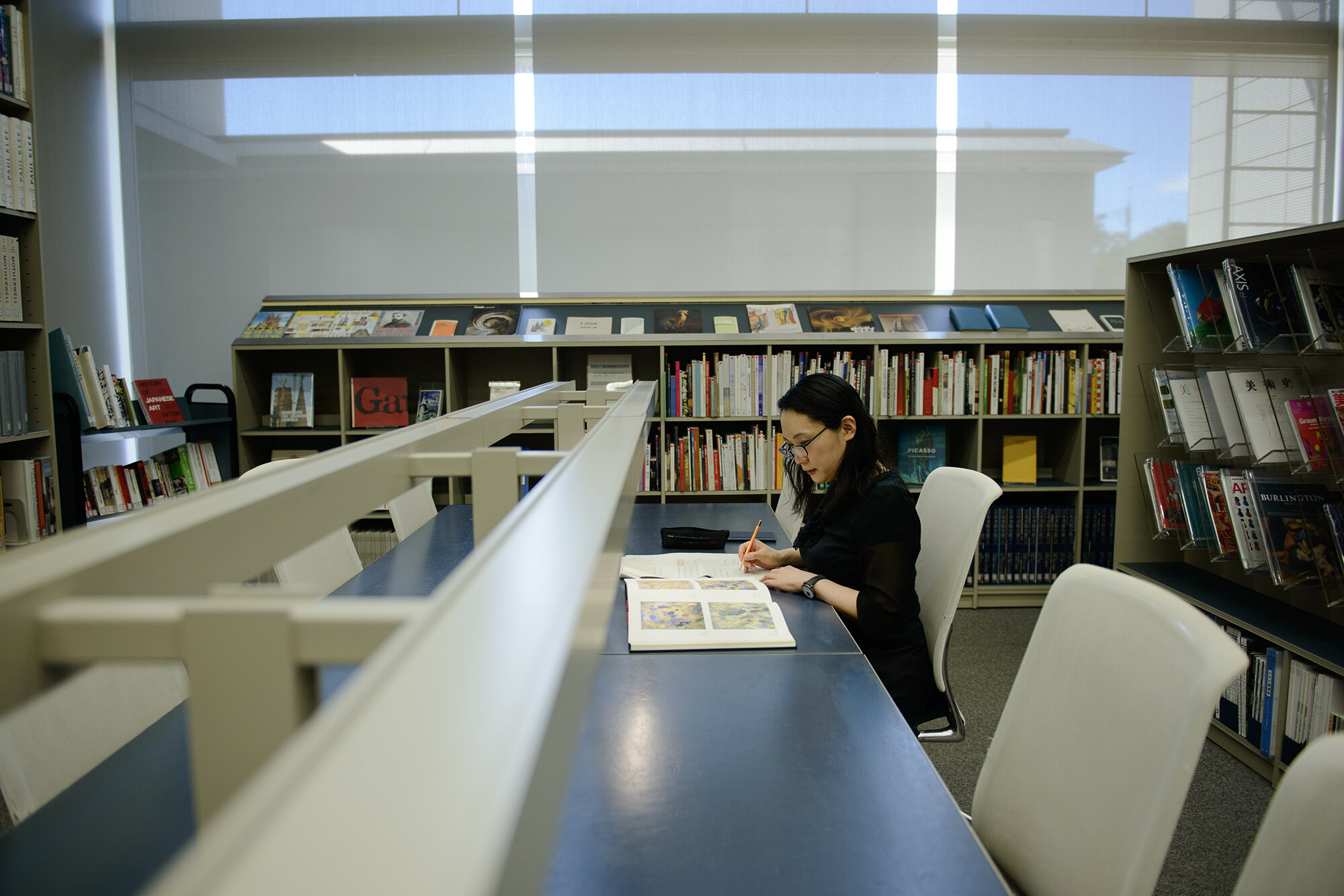
Taniguchi Eri visiting the Art Library at the National Museum of Modern Art, Tokyo, where she is fact-checking manuscripts for the Dictionary of Artists in Japan. (Photograph courtesy of the Art Library, the National Museum of Modern Art, Tokyo)
Ishiguro After graduating from university, I started working in the private sector, and during that time I had a casual job working one or two days a week as a librarian at a cultural facility.
Then, from 2005 I spent seventeen years working as an archivist (a specialist profession involved in collecting, organizing, preserving, and managing historically significant records to enable the information to be browsed) at a public contemporary art museum.
I see the biggest function of that job as the documentation of what was taking place in the art space and the creation of archives to enable this information to be utilized into the future.
I joined that art museum soon after it opened, and the tasks involved in relation to the works held by the museum—organizing images of art works, managing copyright, maintaining records of when works were exhibited, repaired or restored, compiling a collection catalog (of works held by the art museum), updating the collection database and making information available to the public—continued to steadily increase.
As I carried out my role, I was very conscious of the fact that, despite the fact that it was already the 2010s, no significant progress was being made regarding the online release of images and information about holdings in museum collections here in Japan. Revisions to Japan’s Copyright Law in 2018 meant that an image smaller than a specified size could now be made public without permission. To ensure that this improvement of the legal framework is reflected in the research environment, I wanted to become involved in the process of making information on collections available through a comprehensive website that would enable users to visually confirm the holdings of collections throughout Japan. I’d like to see a research environment that enables anyone to use this information to take their research into Japanese art to a deeper level.

Ishiguro Reiko researching documents on artists at the Art Library of the National Museum of Modern Art, Tokyo (Photograph courtesy of the Art Library, the National Museum of Modern Art, Tokyo)
Akita I took archival studies when I majored in art history at grad school, where I developed an understanding of the importance of keeping records and making the records available to the public. That appreciation came from the times when I was conducting my own research and found that there were simply no records, or there were restrictions on accessing information, which meant I couldn’t gain access to the relevant works or reference materials.
After graduate school, I joined a public contemporary art museum where I was involved in managing materials and documents. My primary role was to organize, preserve and to make available to the public materials related to the artist.
Once I began working in this role, I learned how challenging it is to complete the required tasks in a timely fashion with a limited budget and limited human resources. I also discovered that other museums also shared the same issues, and I started to become more aware of the need to solve these issues on a wider scale, transcending the bounds of individual museums.
It was during this time that I came across an ad for a job vacancy at NCAR. I thought it would be a role in which I could gain an overview of the situation in Japan as a whole, and so I applied for the position and got the job.
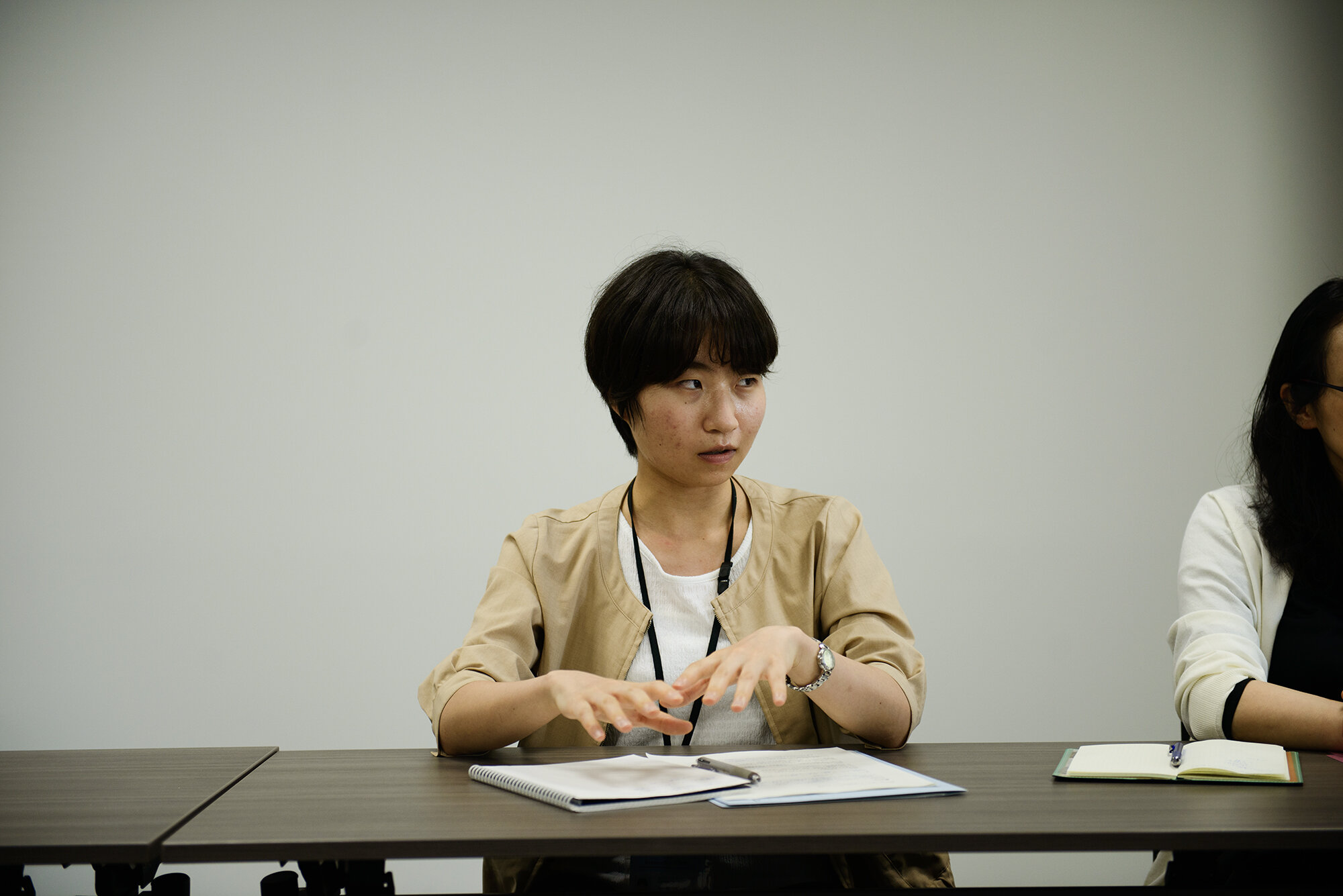
Akita Nami
Recognition of the issues leading up the establishment of NCAR
— Ms Kawaguchi, you were part of the NCAR Preparatory Office while working at NMWA. How was the NCAR organization structured?
Kawaguchi As far as I know, the NCAR concept originated at the (Independent Administrative Institution) National Museum of Art, with all employees notified three years before its establishment in March this year (2023).
Prior to that, and within a completely different context, there was an acknowledgment that insufficient information on art in Japan was being put out, which led to the staff managing information at the national art museums getting together and forming a venue for activities. Everyone recognized the need to improve the information output of individual museums and the need for an art history research center or similar institution.
In retrospect, what we were seeking at the time partially overlaps with what NCAR is involved in.
My understanding is that NCAR was established to address these issues by functioning as a hub where information on art museums throughout Japan is collected and transmitted, so that this information can be utilized in research.
Dictionary of Artists in Japan being created by the Research Resources Group

The project brief, requests for contributions, and progress reports, etc. are shared within the group to ensure seamless communications with third parties, including contributing writers.

The Project Team participating in an online meeting to discuss the Dictionary of Artist in Japan web-based system.
— The creation of a research portal site utilizing the Art Platform Japan* content is currently underway. Can you, as a specific example, describe the editing process for Dictionary of Artists in Japan?
* Art Platform Japan is a website that was originally developed and launched in 2018 as part of the Bunka-cho Art Platform Japan project by Japan’s Agency of Cultural Affairs (2018–2023), with the aim of ensuring the sustained development of contemporary Japanese art. On establishment, NCAR inherited the platform’s content from the Agency of Cultural Affairs, and the website is now commencing operations as NCAR’s research portal.
Kawaguchi Dictionary of Artists in Japan is a comprehensive online dictionary of contemporary and modern artists in Japan.
In contrast to dictionaries in other countries that provide plenty of reference information, dictionaries in Japan are limited. In order to address this situation and provide a solution, we are in the process of compiling a dictionary of artists comprising reference information such as books that refer to a specific artist, or catalogues of solo exhibitions held by the artist.
— One would imagine that the scale of this dictionary requires an enormous amount of work. What system is used to drive the writing and editing process?
Taniguchi As far as who is in charge of what within the group, Kawaguchi and I select the artists and writers and request writers to contribute manuscripts. We also proofread and fact-check the manuscripts, while Ishiguro and Akita are in charge of the reference information, including proofreading and document information.
Kawaguchi Art Platform Japan already has data on well over two thousand artists. From this information, we’ve selected nearly 100 artists who have had exhibitions at the seven national art museums in Japan including the National Museum of Modern Art, Tokyo, and we are in the process of writing, in Japanese, commentaries and reference information.
The content that we’re currently working on will be made available on the website by the end of this fiscal year. Our intention is to continue to increase this information in stages throughout the next fiscal year.
Taniguchi We’ve asked the chief curators and researchers of each national art museum to recommend the best qualified individuals to write the texts. Our first major task will therefore be liaising and coordinating this process.
Kawaguchi Another major issue is related to providing this bilingually once the information has been collected.
For example, let us say that we received information that a book written in Japanese titled “Gendai no Kaiga” is significant. If a researcher overseas attempted to find this book in a Japanese library with the arbitrarily translated title “Contemporary Paintings”, then that researcher would never arrive at the book titled “Gendai no Kaiga”. In order to prevent such a situation, the romanized title—“Gendai no kaiga”—also needs to be included.
As our aim is to create a research portal that’s trusted not only by Japanese universities and art staff, but also by curators and universities overseas. The project is putting particular effort into considering specifically what kind of information is being sought.

Akita editing bibliographic information. The information is separated into columns under categories such as English translation and romanized Japanese.
Japanese art within a global context
Taniguchi As well as compiling this database, we’re putting together a research guide.
It’s like a research guidebook that enables the user to learn, for example, how to use these reference tools to find information about a specific artist.
We believe that enriching this information will result in expanding the art research being carried out, and in enabling the research to go to a deeper level.
As a researcher working in the area of modern and contemporary Japanese art, I’m concerned that Japanese art will be increasingly marginalized if a robust and comprehensive research environment is not established. In order to address this issue, it’s important that the right environment is created to encourage research into Japanese art, and to ensure that it is accessible to overseas researchers bringing new perspectives.
To realize this, standardized and compatible information must be provided properly in a bilingual format.
Kawaguchi I’m always thinking about the importance of creating the right environment for Japanese artists to be more actively featured and showcased within a global context.
The establishment of a portal site that becomes the first stop for art research will make information on Japanese artists readily accessible worldwide, putting them on a par with artists from other countries.
I am convinced that our work contributes to the discovery of the significance of Japanese art from many different perspectives and within a variety of contexts, and that this will result in deeper research into Japanese art, connecting it to a new future.
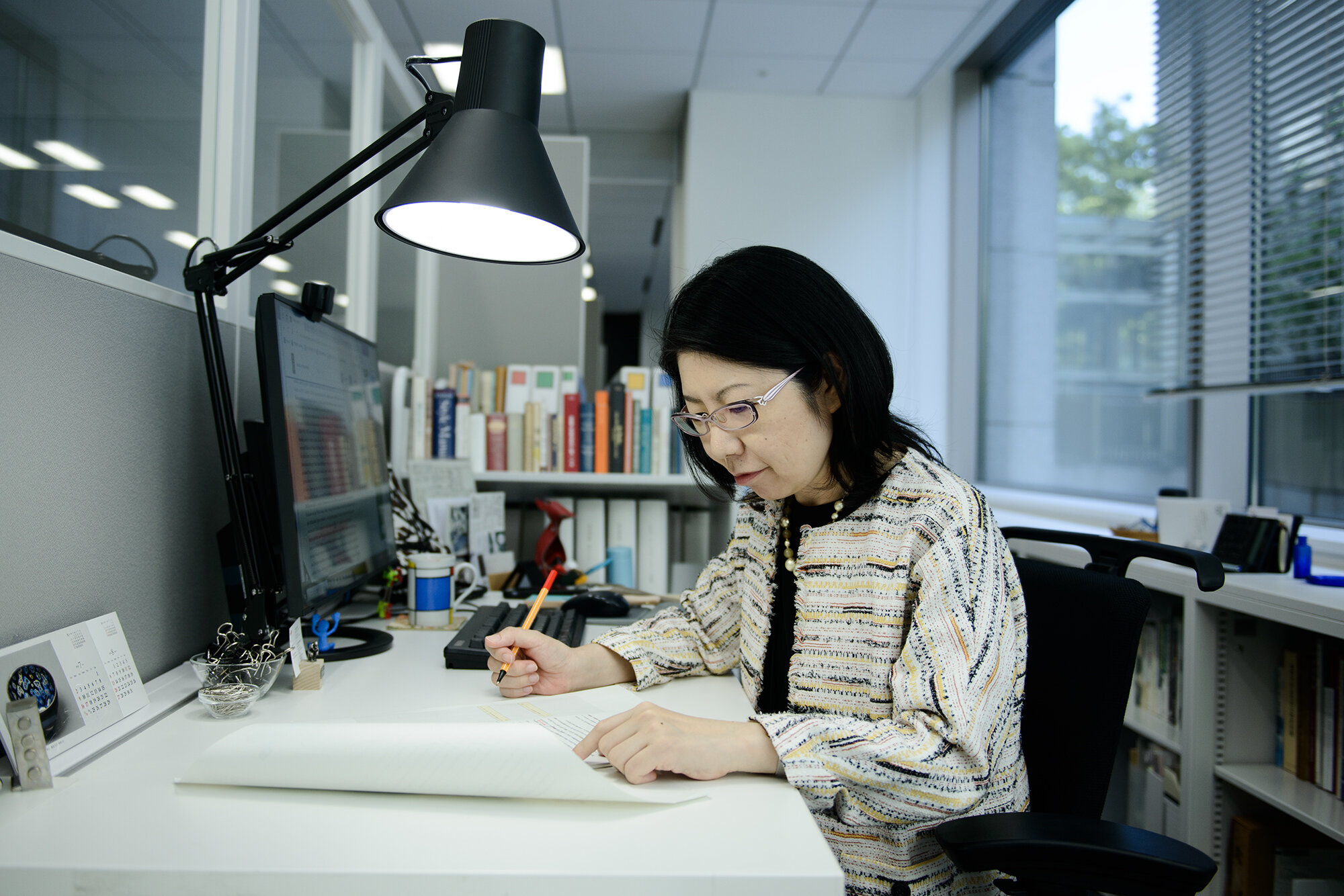
Kawaguchi correcting proofs
(Report/interviews and photographs by Nakajima Ryohei)







